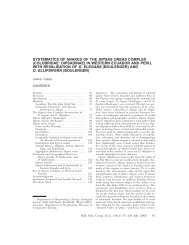cryptic species within the dendrophidion vinitor complex in middle ...
cryptic species within the dendrophidion vinitor complex in middle ...
cryptic species within the dendrophidion vinitor complex in middle ...
Create successful ePaper yourself
Turn your PDF publications into a flip-book with our unique Google optimized e-Paper software.
SPECIES IN THE DENDROPHIDION VINITOR COMPLEX N Cadle 203<br />
Figure 9. Dendrophidion apharocybe <strong>in</strong> life. AMNH R-115922 from cont<strong>in</strong>ental divide N of El Copé, Panama (Coclé Prov<strong>in</strong>ce).<br />
Adult female, 666 mm SVL. From color slide by Charles W. Myers. A reverse image of <strong>the</strong> same photo was published <strong>in</strong> Köhler<br />
(2003: fig. 478, 2008: fig. 580).<br />
Savage (2002: 656), Guyer and Donnelly<br />
(2005: 185), McCranie et al. (2006: 148),<br />
McCranie (2011: 112), and Charles W.<br />
Myers (field notes for KU 107646; AMNH<br />
R-108693, R-115922, R-119377) <strong>in</strong>clude a<br />
gray to brown dorsum with a series of darkedged<br />
pale grayish to pale brown crossbands<br />
(ground color or crossbands often with<br />
reddish or orange tones, especially on head,<br />
anterior and midbody). Posteriorly, pale<br />
bands tend to become <strong>in</strong>vested with dark<br />
pigment, form<strong>in</strong>g transverse series of pale<br />
ocelli set <strong>with<strong>in</strong></strong> darker pigment. Posterior<br />
ocelli are not mentioned <strong>in</strong> all color<br />
descriptions, but <strong>the</strong>y are visible <strong>in</strong> virtually<br />
every published photo from throughout <strong>the</strong><br />
range. Often a pale vertebral l<strong>in</strong>e posteriorly.<br />
Usually a narrow lateral dark l<strong>in</strong>e on<br />
dorsal rows 2 and/or 3 on <strong>the</strong> posterior body<br />
(sometimes <strong>in</strong>dist<strong>in</strong>ct) and a similar dark<br />
l<strong>in</strong>e at <strong>the</strong> subcaudal/dorsocaudal border.<br />
Sk<strong>in</strong> between <strong>the</strong> anterior dorsal scales pale<br />
blue or bluish white. Top of head brown,<br />
sometimes <strong>in</strong>vested with reddish or greenish<br />
tones. Supralabials and throat pale to<br />
bright yellow. Venter <strong>in</strong> adults whitish to<br />
yellow, often with an orangish or greenish<br />
wash. Juveniles similar to adults but reddish<br />
or orange tones <strong>in</strong> dorsal ground color<br />
reduced or absent; venter usually whitish,<br />
greenish white, or orange/yellow.<br />
Guyer and Donnelly (2005: 185) described<br />
specimens from <strong>the</strong> type locality as<br />
follows: Dorsum gray brown anteriorly,<br />
shad<strong>in</strong>g to brown posteriorly. Crossbands<br />
pale grayish tan bordered by dark. Anteriormost<br />
<strong>in</strong>terspace between pale bands rusty<br />
red, <strong>the</strong> rest gray brown. Sk<strong>in</strong> between <strong>the</strong><br />
anterior dorsal scales pale blue, creat<strong>in</strong>g a<br />
bluish t<strong>in</strong>t to <strong>the</strong> light bands or, when <strong>the</strong><br />
lung is expanded, a blue band. Posterior<br />
body middorsal tan stripe <strong>in</strong>terrupted by<br />
th<strong>in</strong>, dark bands that shade to gray laterally.<br />
Venter immaculate white to light yellow.<br />
Head gray brown. Supralabials brownish<br />
anteriorly, white to pale yellow posteriorly.<br />
Figure 9 illustrates an adult female D.<br />
apharocybe from Panama, whose coloration<br />
<strong>in</strong> life was described thus (Charles W.<br />
Myers, field notes): Head brown, turn<strong>in</strong>g<br />
gray-brown on neck and <strong>the</strong>n greenish<br />
brown over rest of body. Pale crossbands<br />
gray anteriorly, pale orange at midbody,<br />
pale brown posteriorly. Sk<strong>in</strong> <strong>with<strong>in</strong></strong> cross-<br />
Bullet<strong>in</strong> of <strong>the</strong> Museum of Comparative Zoology harv-160-04-01.3d 11/4/12 19:58:56 203







